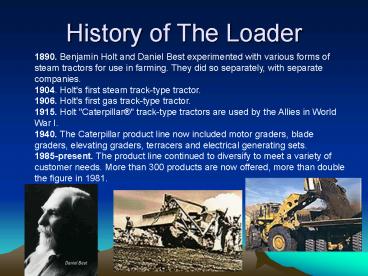History of The Loader - PowerPoint PPT Presentation
1 / 11
Title:
History of The Loader
Description:
... separately, with separate companies. 1904. Holt's first steam track-type tractor. ... Faster, fewer moving parts, cheaper to repair/replace wheels as opposed to ... – PowerPoint PPT presentation
Number of Views:70
Avg rating:3.0/5.0
Title: History of The Loader
1
History of The Loader
1890. Benjamin Holt and Daniel Best experimented
with various forms of steam tractors for use in
farming. They did so separately, with separate
companies. 1904. Holt's first steam track-type
tractor. 1906. Holt's first gas track-type
tractor. 1915. Holt "Caterpillar" track-type
tractors are used by the Allies in World War
I. 1940. The Caterpillar product line now
included motor graders, blade graders, elevating
graders, terracers and electrical generating
sets. 1985-present. The product line continued
to diversify to meet a variety of customer needs.
More than 300 products are now offered, more than
double the figure in 1981.
2
Skid Steer Loaders
Virtual Tour
3
Backhoe Loader
Virtual Tour
4
Wheel Loader
Virtual Tour
5
Track Loader
Specs Attachments
6
Trenchers
7
Types of Trenchers
8
Attachments
- cable installation for residential purposes
- Rock Wheel
9
Uses for Trenchers
- Mini / Walk-along and Medium-size riding models
- Underground sprinkler systems, water and gas
service lines, telephone, and TV and cable lines. - Large, multi-purpose machines
- Fiber optic cable, water and natural gas
distribution systems, electrical cable for
freeway and urban traffic signal systems
10
Prices
- Loaders
- Wheel
- 216B (Smallest Cat Skid Loader) 30,000.00
- 994F (Largest Cat Front Loader) 3.8 million
- Track
- 277B (Smallest Cat Track Loader) 60,000
- 973C (Largest Cat Track Loader)
350,000-400,000 - Trenchers
- Walk Behind
- E-Z Trench Cable installer (Walk-Behind) 1,350
- Vermeer RT60 (Smallest Walk-Behind) 3,000
- Vermeer RT200 (Largest Walk-Behind) 10,000
- Wheel Riding Trenchers
- Vermeer RT350 20,000
- Vermeer RT950 65,000
- Track Riding Trenchers
- Vermeer RTX1250 85,000
- Vermeer T1255 Commander 1million
11
Considerations
- Wheel Machines
- Pros
- Faster, fewer moving parts, cheaper to
repair/replace wheels as opposed to treads, more
fuel efficient. - Cons
- Less stable base over uneven terrain, less
traction means less ripping power - Track Machines
- Pros
- More stable base over uneven terrain, more
pulling/pushing power, more weight disbursement - Cons
- Slower, less fuel efficient, more moving parts to
maintain































